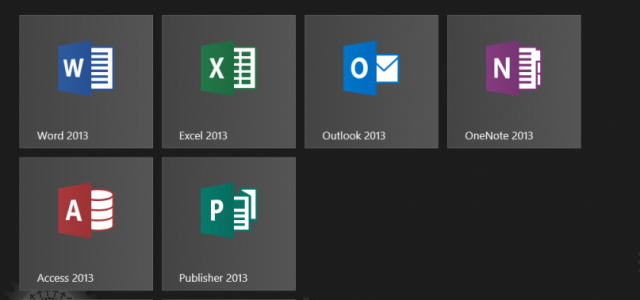
Today, Microsoft releases Office 2013—the first full release of Microsoft's latest-generation productivity suite for consumers. Office 2013 has already made a partial debut on Microsoft's Windows RT tablets, though RT users will get a (slight) refresh with the full availability of the suite. The company gave consumers an open preview of Office last summer, which wereviewed in depth at the time of the suite's announcement.
So there aren't any real surprises in the final versions of the applications being releasing today, at least as far as how they look and work. Today's release, however, marks the first general availability of Microsoft's new subscription model under the Office 365 brand the company has used for its hosted mail and collaboration services for businesses. While the applications in Office are being offered in a number of ways, Microsoft is trying hard to steer consumer customers to Office 365 Home Premium Edition, a service-based version of the suite that will sell for $100 a year.
And just as Windows 8's app store started to fill up as the operating system approached release, the same is true of Office's own app store—an in-app accessible collection of Web-powered functionality add-ons for many of the core Office applications based on the same core technologies (JavaScript and HTML5) that power many of Windows 8's interface-formerly-known-as-Metro apps. Now, the trick is getting consumers to buy into the idea of Office as a subscription service and embracing Microsoft's Office "lifestyle," instead of something they buy once and hold onto until their computers end up in the e-waste pile.
The pompatus of Office
Microsoft has done a lot to sweeten the pot to attract consumers into the subscription model, enlisting nearly everything but the Publisher's Clearinghouse Sweepstakes. While the lowest-cost perpetual-license version of Office 2013—Office 2013 Home and Student—is priced at just under $140 and includes the four core applications (Word, PowerPoint, Excel, and OneNote), Office 365 Home Premium Edition comes with all of those applications plus the Outlook mail and calendar client, Access database, and Publisher desktop publishing tool.
Home Premium also comes with licenses for five installs of the suite—including Office 2011 for Mac installs for those households with mixed operating system allegiances. Home and Student has been trimmed down to allowing just one installation per license. And as part of its subscription, customers will also get 60 minutes a month of Skype calls to phone numbers within the US (as Microsoft continues to position Skype as the consumer version of its Lync enterprise voice, video, and messaging service). And it comes with an additional 20 gigabytes of SkyDrive cloud storage.
We've reviewed most of these applications in depth, but it's worth reviewing the major changes to them one more time in case you missed Microsoft's Office 2013 marketing machine. The biggest change across the board is that the interfaces for all of the Office apps have been thematically updated in an attempt to make them less cluttered and more amenable to tablet users. There's also a new add-on "app" interface for Office that plugs into most (but not all) of the applications in Home Premium.
The most heavily updated of the applications in terms of functionality is Word 2013. Its collaboration capabilities have been updated. While Office 2010 provided some SkyDrive-based document sharing, Word 2013 adds a co-editing capability that allows multiple people to work on a SkyDrive (or SharePoint) shared doc. It's not Google Docs in terms of live joint editing, but it's a step forward. Another gift to collaborators is a new simplified markup process for tracking changes and comments that allow collaborators to leave threaded discussions on the content.

The clean, painless reader-oriented navigation view in Word 2013, with the simplified markup for comments demonstrated.
Since Microsoft sees more users reading Word documents online instead of in print, the Office team added a view just for reading documents (particularly suited for people who read Word docs from tablets). Word now also has online content embedding—including videos—and provides better image placement and layout tools. Perhaps most important to anyone who deals with masses of PDF documents, Word now has full PDF import, too.
Outlook 2013 has been tweaked heavily in the name of making it equally desktop and tablet friendly. There are mouse-hover popups that show contextually appropriate information, taking Windows 8's "People" feature and putting it on steroids. This feature extends Microsoft's “social connector" social networks integration, so the mail and contact management software now detects when a person has multiple contact cards and merges them into a single “people card” view. Other new features of the interface include “peeks,” which allow you to hover the mouse pointer over the tabs for the various parts of Office’s interface (Calendar, People, and Tasks) and get a pop-up view of what lies beneath. There's also now the ability to write in-line replies in Outlook's message preview pane, reducing the amount of window bouncing required to get a quick answer off to someone.
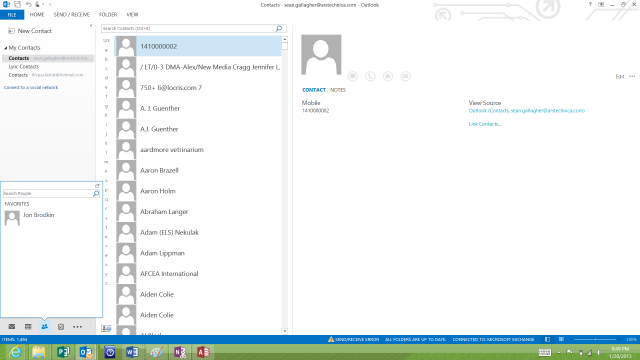
A look at Outlook's "peeks" within the contact management view.
Excel 2013 takes more of the high-end features for data analysis and charting—formerly the domain of Excel power users—and puts them within easier grasp of casual users. (You may now find friends publishing Pivot Tables that analyze their fantasy football teams.) The Quick Analysis “lens,” a feature activated when you highlight a block of cells, provides some canned charting, formatting, and data processing options—including Pivot Tables—based on a pattern analysis of the content in the selected cells. It will also be easier to convert those roster stats copied from webpages into useful data, thanks to a new “flash fill” feature. Flash fill uses pattern analysis to detect when a user is retyping content from another column, then automatically fills the rest of the column out.
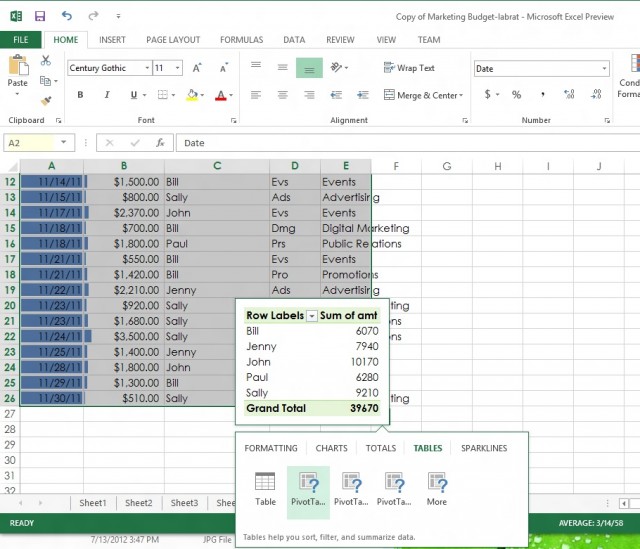
The Quick Analysis "lens" can look at the columns of data in a selected block of cells and suggest auto-created pivot views based on their contents, previewing the table before you click it.
PowerPoint 2013 has become an online content-borrowing machine. Users can grab images from beyond the Office template library—from social networks and other image-sharing sites—while searching and browsing them directly from the PowerPoint interface. There are new drawing and charting tools to help create what can't be appropriated from elsewhere, and a new presenter mode is targeted at making it easier for tablet-luggers to plug into a display and have their notes in front of them.
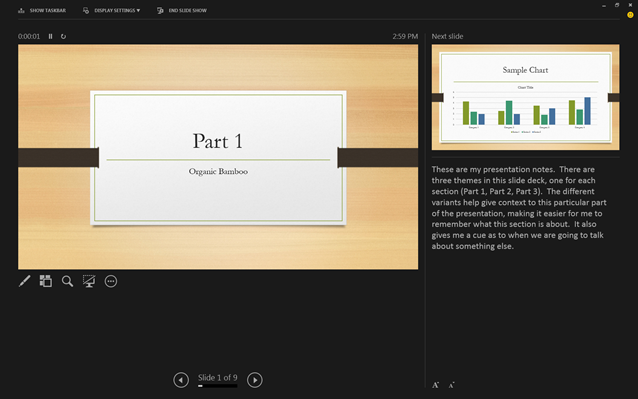
PowerPoint's new Presenter view showing what's now and next, along with slide notes.
We didn't look at Access 2013 in our initial review of the Office preview, but it's clear Microsoft has very specific cloud-based plans for the database tool. Unfortunately, for most home users, its one really impressive new feature—the ability to create database Web applications—is sort of moot. This is because its incarnation in Home Premium requires a SharePoint server with the proper templates to support it. Access has dramatically simplified the process of creating database applications. For home users, it's relatively painless to create and build local databases without doing any coding.

Creating input forms for Access databases is drag-and-drop painless. Sadly, there's no way to publish the forms as a Web application to anything other than SharePoint in the Home Premium Edition release.
As a former FoxPro developer, I kept looking for places to write my legacy Clipper code. There is a Visual Basic for Applications editor, but that's a rabbit hole most average Office users will not want to go down. Access doesn't take advantage of any of the Office store app technology, so you'll have to roll your own integration with Web services if you want to do that visualization—either that, or connect to your Access database with Excel. We'll take a deeper look at Access when we review the still-pending general release of Office Pro, Exchange, and SharePoint.
OneNote 2013, the information organizing application, was the only one of the core Office applications to get a full Windows 8 makeover with a Metro interface. However, the Metro interface used in Office on Windows RT didn't get installed when I loaded up Home Premium. Instead, I got the standard desktop interface only. It is good at collecting information from screen shots, Web clippings, and randomly scrawled notes. Peter Bright has looked deeply into OneNote, and I've tried to use it some myself. Its usefulness increases exponentially if you're a Windows Phone 8 owner. I guess.
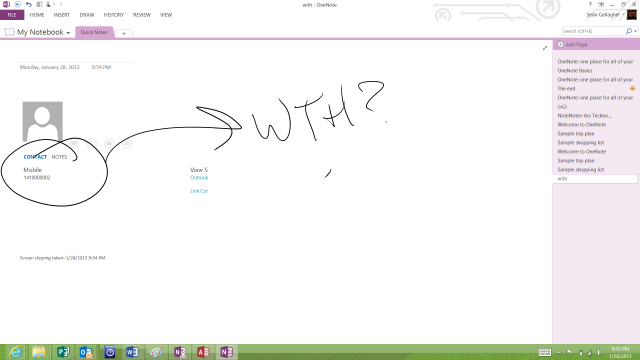
Some day, I'll actually figure out something useful to do with OneNote 2013.
Finally, one application we didn't look at in our Office preview reviews was Publisher, Microsoft's desktop document publishing tool that also has some basic Web publishing capabilities.
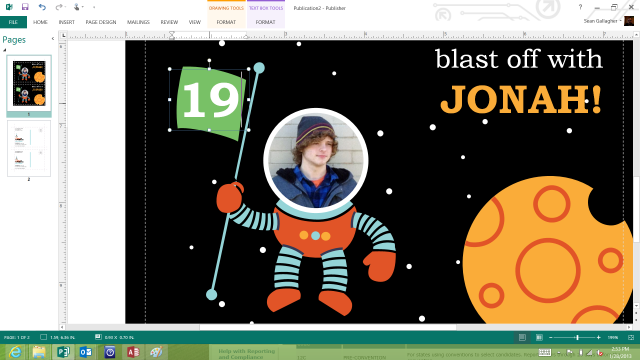
Publisher 2013 hooks into Office.com's ever-growing template library, much to the dismay of my soon-to-be 19-year-old son.
Thanks for sharing valuable infomration on microsoft content please share more content MSBI Online Training Bangalore
ReplyDelete